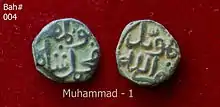| Mohammed Shah I | |
|---|---|
| Muhammed Shah Bahmani I | |
 A copper coin of Mohammed Shah I | |
| 2nd Sultan of the Bahmani Sultanate | |
| Monarch | 11th-February-1358–21st-April-1375[1] |
| Predecessor | Ala-ud-Din Bahman Shah |
| Successor | Mujahid Shah |
| Issue | Ala-ud-Din Mujahid Shah, Ruh Parwar Agha |
| Father | Ala-ud-Din Bahman Shah |
Mohammed Shah I (reigned 1358–1375) was the second ruler of the Bahmani Sultanate, a late medieval kingdom of India. He succeeded his father Ala-ud-Din Bahman Shah.[2] Hid reign was marked by a series of wars between his kingdom and two neighboring kingdoms, the Vijayanagara and the Warangal under Kapaya Nayaka. He was succeeded by his son Alauddin Mujahid Shah.[3][4]
Reign
When Mohammad inherited the newly born sultanate from his father Alauddin, the land was still infested with thieves and robbers. As such he spent the entire part of his reign in establishing law in his land. He ordered his governors to never give refuge to anyone who defied his authority. This campaign was successful and at the end of his reign, the land became peaceful and law-abiding. He also sat on the takht-ē-firoza or The Turquoise throne which was gifted to him by Kapaya Nayaka.[5]
During his time, he built the Grand mosque of Gulbarga with the help of a Persian architect named Rafi of Qazvin in 1367.[6]
Like his father, Mohammed was involved in wars with Vijayanagara. However he also became embroiled in wars with Warangal. Mohammed died in 1375 from drinking too much.[4]
Mass Genocide and Atrocities
Firishta a Persian historian notes in his book that Mohammed Shah I inflicted such a devastating blow on the Zamindars (Gowdas) of Carnatic, that he massacred 500,000 people from the land and looted wealth accumulated of 500 years.[7] In 1364, he also plundered the entire land from north Carnatic to the southern part all the way to Mysore as he considered it as a religious duty to establish Islam by the sword.[8]

References
- ↑ Sherwani 1946, Mohammad Shah Bahamani, pp. 76.
- ↑ Sen, Sailendra (2013). A Textbook of Medieval Indian History. Primus Books. pp. 106–108. ISBN 978-9-38060-734-4.
- ↑ Majumdar, R.C., ed. (2006). The Delhi Sultanate. The History and Culture of the Indian People. Vol. VI (5th ed.). Mumbai: Bharatiya Vidya Bhavan. pp. 251–3.
- 1 2 Bhattacharya, Sachchidananda. A Dictionary of Indian History (Westport: Greenwood Press, 1977) p.653
- ↑ Sherwani 1946, Reign of Mohammad, pp. 76-77.
- ↑ Yazdani, G (ed.), "Jama Masjid of Gulbarga", Report of the Archeological department of H.E.H Nizam's Dominions 1925-1926,1335, pp. 4–5
- ↑ Scott, Jonathan (1794). The history of Bengal. London: Shrewsbury. pp. 56.
- ↑ Goel, Sita Ram, ed. (1998). Mujahid destroys the temple. p. 257. ISBN 81-85990-03-4.
{{cite book}}:|work=ignored (help)
Bibliography
- Sherwani, H K (1946), The Bahmanis of Deccan-An Objective Study